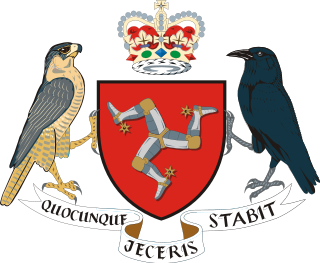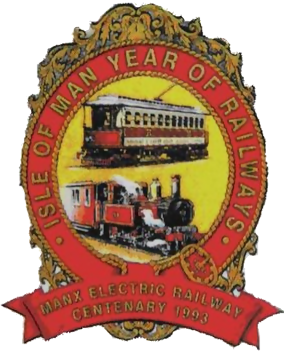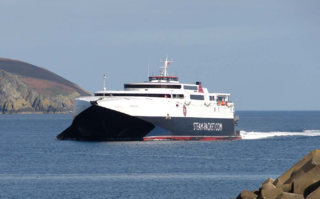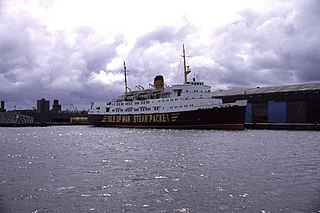There are a number of transport services around the Isle of Man, mostly consisting of paved roads, public transport, rail services, sea ports and an airport.

Laxey is a village on the east coast of the Isle of Man. Its name derives from the Old Norse Laxa meaning 'Salmon River'. Its key distinguishing features are its three working vintage railways and the largest working waterwheel in the world. It is also the location of King Orry's Grave.

Ramsey is a coastal town in the north of the Isle of Man. It is the second largest town on the island after Douglas. Its population is 8,288 according to the 2021 Census. It has one of the biggest harbours on the island, and has a prominent derelict pier, called the Queen's Pier. It was formerly one of the main points of communication with Scotland. Ramsey has also been a route for several invasions by the Vikings and Scots.

The Manx Electric Railway is an electric interurban tramway connecting Douglas, Laxey and Ramsey in the Isle of Man. It connects with the Douglas Bay Horse Tramway at its southern terminus at Derby Castle at the northern end of the promenade in Douglas, and with the Snaefell Mountain Railway at Laxey. Many visitors take an excursion on the trams. It is the oldest electric tram line in the world whose original rolling stock is still in service.

Isle of Man Airport is the main civilian airport on the Isle of Man. It is located in the south of the island at Ronaldsway near Castletown, 6 nautical miles southwest of Douglas, the island's capital. Along with the Isle of Man Sea Terminal, it is one of the two main gateways to the island. The airport has scheduled services to the United Kingdom and the Republic of Ireland.

The Isle of Man Steam Packet Company Limited is the oldest continuously operating passenger shipping company in the world, having been founded in 1830.

Manx National Heritage is the national heritage organisation for the Isle of Man. The organisation manages a significant proportion of the Island’s physical heritage assets including over 3,000 acres of coastline and landscape. It holds property, archives, artwork, library and museum collections in trust for the Manx nation. It is the Isle of Man's statutory heritage agency and an Isle of Man registered charity (№ 603).

SS (RMS) Ellan Vannin was built as an iron paddle steamer in 1860 at Meadowside, Glasgow for the Isle of Man Steam Packet Company. She was originally named Mona's Isle - the second ship in the company's history to be so named. She served for 23 years under that name before being rebuilt, re-engined and renamed in 1883. As Ellan Vannin she served for a further 26 years before being lost in a storm on 3 December 1909 in Liverpool Bay.

Isle of Man Public Transport, also known as Isle of Man Transport and Isle of Man Transport Services, is a division of the Isle of Man Government's Department of Infrastructure that operates public transport on the Isle of Man.

The Year of Railways was a series of special events held on the Isle of Man during 1993 to commemorate the centenary of the opening of the first section of the Manx Electric Railway from Douglas to Groudle in September 1893.
Manx Line was a ferry operator which operated roll-on/roll-off ferry services between Great Britain and the Isle of Man between 1978 and 1985. An earlier, unrelated, company had used the "Manx Line" name in the late 19th century.

HSC Manannan is a 96-metre (315 ft) wave-piercing high-speed catamaran car ferry built by Incat, Australia in 1998. After commercial service in Australia and New Zealand, she was chartered to the US military as Joint Venture (HSV-X1). Now owned and operated by the Isle of Man Steam Packet Company, she mainly provides a seasonal service between Douglas Harbour and Port of Liverpool.

Bus Vannin - styled as bus vannin - is the government-owned and operated bus service on the Isle of Man. The name was adopted in June 2009 to replace Isle of Man Transport. The company was founded on 1 October 1976, as National Transport, which was an amalgamation of two other operating companies.

Douglas Harbour is located near Douglas Head at the southern end of Douglas, the capital of the Isle of Man. It is the island's main commercial shipping port. The Port of Douglas was the first in the world to be equipped with radar.

Heysham Port is situated by the village of Heysham, Lancashire, England. The harbour ships mainly roll-on/roll-off freight with one passenger service run by the Isle of Man Steam Packet Company, which operates a twice daily sailing to Isle of Man. There are three freight routes run by Seatruck Ferries and Stena Line which all sail to Ireland daily. The passenger terminal has a rail service which links to Lancaster via Morecambe. Also adjacent to the dock site is a Heysham nuclear power station which was built between 1970 and 1988.

TSS (RMS) Manx Maid (II) was built by Cammell Laird at Birkenhead in 1962, and was the second ship in the Company's history to bear the name.

TSS (RMS) Ben-my-Chree (V) was the second of four side-loading car ferries ordered by the Isle of Man Steam Packet Company. Built in 1965, she was the last of their vessels designed with two classes of passenger accommodation and the fifth company vessel to bear the name. She operated until 1984 and was broken up in 1989.

The Laxey Towing Company Ltd is a privately owned marine salvage company incorporated in the Isle of Man. Its registered office is Clovenstones Cottage, Baldrine, with its company offices situated at 30, North Quay, Douglas, Isle of Man. The company operates under the managerial directorship of Captain Stephen Carter, providing pilotage facilities for the Port of Douglas and has over many years operated a wide variety of services throughout the harbours of the Isle of Man. Up to 2017 it also operated summer coastal cruises on board the pleasure cruiser, MV Karina.

SS (RMS) Ellan Vannin was an iron-built packet steamer which was operated out of Castletown, Isle of Man for the Castletown Steam Navigation Company to Liverpool and Whitehaven. Her name, Ellan Vannin, came from the Gaelic term by which the Isle of Man is known.

James Teare was a Manx merchant navy officer who served as a seaman and later as an officer on numerous Isle of Man Steam Packet Company vessels. Capt. Teare is best known as the Master of the RMS Ellan Vannin on her ill-fated voyage from Ramsey, Isle of Man to Liverpool on 3 December 1909.






















